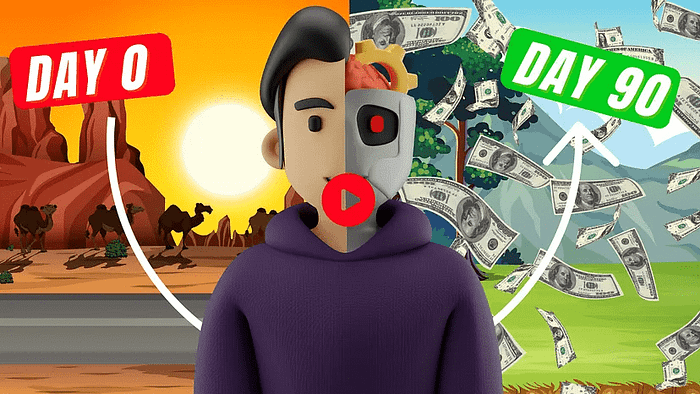The FASTER Way to Create Online Courses With AI: A Game-Changing Approach
Create Online Courses With AI: Have you ever dreamed of developing educational content that truly helps people? I’m about to reveal how to create online courses with AI, using lightning speed and precision. This innovative approach will revolutionize your course creation process, helping you outline, structure, and even develop marketing materials for your entire course. By learning to create online courses with AI, you’ll be able to produce high-quality content efficiently.
We’re living in an era of information overload, and as a course creator and buyer myself, I’ve seen firsthand how overwhelming some courses can be. It’s not uncommon to come across courses with over 200 hours of content – that’s simply too much for most people to digest effectively.
Our time is precious, and that’s why short, problem-focused courses are incredibly valuable. These concise courses, typically ranging from 40 to 90 minutes, are designed to address specific issues and provide tangible solutions.
By focusing on creating targeted content, you can help thousands of students achieve their goals without overwhelming them with unnecessary information. This approach has proven successful across various communities, resulting in higher engagement and satisfaction rates. When you create online courses with AI, you’ll be able to deliver this focused content more effectively than ever before.
We strongly recommend that you check out our guide on how to take advantage of AI in today’s passive income economy.
Table of Contents
Identifying Your Audience’s Pain Points
Before diving into the process of using AI to create online courses, it’s crucial to understand your audience’s needs. Without this foundation, you risk creating a course that doesn’t resonate with your target market.
To begin, we need to narrow down our ideal customer profile (ICP) and identify their pain points. This step is essential in developing a unique selling proposition (USP) that sets your course apart from the competition.
Leveraging AI for Audience Research
AI tools like ChatGPT or Claude can be invaluable in brainstorming potential problems your audience might face. By using a simple prompt, you can generate a wealth of information about your target market.
For example, you could use a prompt like: “My niche is XYZ, and I help X with Y. Help me generate my ICP and USP, then create 25 common challenges and pain points faced by my target audience.”
Refining Your Unique Selling Proposition
Once you have a list of potential pain points, it’s time to refine your USP. Your USP should clearly communicate how your course solves a specific problem better than any other available solution.
This unique angle will be crucial in your marketing efforts and will help you stand out in a crowded marketplace. Remember, the key to create online courses with AI is to focus on solving real problems for real people.
Outlining Your Course with AI Assistance
Now that we’ve identified our audience and their pain points, it’s time to create the backbone of our course. This is where AI truly shines in helping us create online courses efficiently.
Using AI-Powered Prompts for Course Structure
To create a comprehensive course outline, we’ll use a specialized prompt that helps generate an initial structure. This prompt, inspired by tools like Write with AI, can be customized to fit your specific needs.
The prompt should include key elements such as the main topic, target audience, unique angle, and any specific ideas you want to incorporate. By providing this information to the AI, you’ll receive a well-structured outline that serves as an excellent starting point.
Refining the AI-Generated Outline
While AI can create a solid foundation, it’s essential to review and refine the outline to ensure it aligns with your teaching style and meets your audience’s needs. Focus on creating a structure that can be covered within 1 to 3 hours, keeping in mind the importance of concise, problem-focused content.
As you refine your outline, consider using project management tools like Trello to organize your course materials, including videos, email marketing, templates, and checklists. This systematic approach will help you create online courses with AI more efficiently.
Developing Course Marketing Materials
With your course outline in place, it’s time to focus on creating compelling marketing materials. AI can be a powerful ally in this process, helping you craft everything from launch plans to sales copy.
Creating a Launch Plan
Use AI to generate a comprehensive 90-day course launch plan. This plan should include pre-launch activities, content marketing strategies, email sequences, and the actual launch phase. By following a well-structured plan, you’ll maximize the impact of your course release.
Generating Bonus Ideas
Leveraging AI tools like the Perfect Bonus Generator can help you create irresistible bonus offerings for your course. These bonuses can include PDF guides, video tutorials, templates, or exclusive interviews that complement your main course content.
Building a Simple Sales Funnel
To effectively market and sell your course, you’ll need a straightforward sales funnel. While AI can assist with certain aspects, the overall structure typically includes a waitlist or webinar page, an email sequence, and a sales page.
Creating Landing Pages and Email Sequences
Utilize tools like ConvertKit or Luma to create landing pages for your waitlist or webinar. These platforms make it easy to design professional-looking pages and manage registrations.
For your email sequence, use AI to draft a 5-7 day email campaign that nurtures your leads and builds excitement for your course launch. Remember to infuse your personal voice and experiences into these AI-generated emails for authenticity.
Transforming Your Course into a Community
To create online courses with AI that truly resonate with students, consider turning your course into a community-powered experience. Many learners value the opportunity to connect with both the instructor and fellow students.
Choosing the Right Platform
Platforms like Kajabi or Mighty Networks offer robust features for hosting courses and building communities. These all-in-one solutions allow you to manage your course content, facilitate discussions, and even host live workshops or Q&A sessions.
Fostering Engagement
Use AI to generate ideas for ongoing support and engagement after the course ends. This could include prompts for discussion threads, ideas for live sessions, or suggestions for additional resources to share with your community.
Conclusion
By harnessing the power of AI to create online courses, you can dramatically reduce the time and effort required to develop high-quality educational content. Remember, the goal is not to replace your expertise but to enhance it, allowing you to focus on delivering value to your students.
As you embark on your journey to create online courses with AI, keep in mind that you don’t need to be the ultimate expert in your field. Being just a few steps ahead of your audience is often enough to provide valuable insights and guidance.
By following this AI-assisted approach, you’ll be well-equipped to create impactful, problem-focused courses that truly help your students achieve their goals. So, are you ready to revolutionize your course creation process and make a lasting impact on your students’ lives?

We strongly recommend that you check out our guide on how to take advantage of AI in today’s passive income economy.




